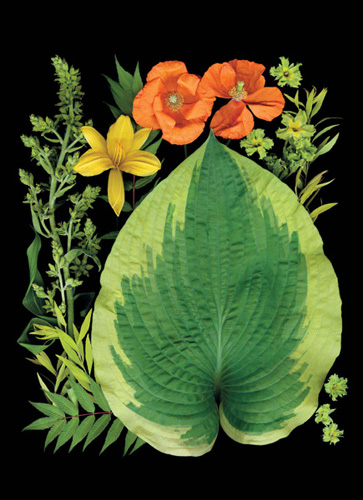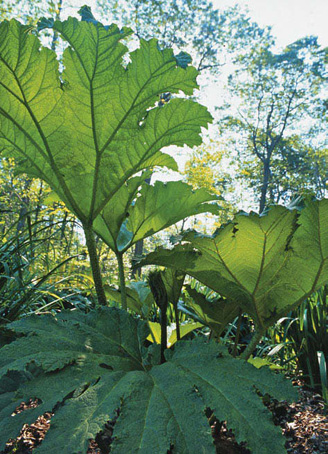
Diversity in late spring, clockwise from top left: tiny buds and a few flowers line the two-foot flower spike of Veratrum viridis; small yellow Hemerocallis lilioasphodelus; Papaver atlanticum; green primrose Primula ‘Francesca’; yellow-green leaves of Caryopteris x clandonensis ‘Worcester Gold’; Hosta ‘Frances Williams’ and the ferny leaf of Sorbaria sorbifolia*.

The full-page scans in this book are in scale to each other. These photographs show what fits on Ellen’s large flatbed scanner. So, the largest leaves in the garden cannot make it onto the glass surface, for instance Gunnera manicata (Zones 7–10) with leaves five or more feet across. Small plants could, of course, like the cranberry (Vaccinium macrocarpon Zone 2–6), which can be grown as a fruiting ground cover. The cranberry’s leaves are the size of your pinky nail. Macrocarpon means big fruit, and compared to the leaves, the berry is huge. If hostas had fruits of a similar scale, they would be watermelons. The flowers of the cranberry are small and look like the head of a pink crane, perhaps the source of its common name.
When we think of big leaves in our gardens, hostas come to mind. Of course, there is a range— H. venusta leaves could be compared to tablespoons. H. ‘Sum and Substance’ has green-gold leaves about two feet long. Generally, the scale of a landscape is set by surrounding trees, walls, and paving— the permanent elements. But we find ourselves concentrating on the plants at human scale, from our toes to the tops of our heads. The larger foliage establishes the scale of a planting. Distinguish the large leaves with smaller ones and small flowers for lively combinations.
A garden with plants of all the same size might read as an interesting “lake” made of foliage, or as easily, be static and boring. Relieve the monotony with contrasting scale, which creates energy and movement and makes it easy to enjoy as your eyes scan along, delighting in the rhythm of the arrangement.
The idea is to use various sizes of flowers. If you have some giant herbaceous meadow hibiscus with blooms as large as dinner plates, modify their impact with equally large aggregations of blossoms, for example Hydrangea paniculata ‘Grandiflora’. Massing plants with individual blossoms might also work; perhaps Hemerocallis ‘Corky’ with scores of small fluttering daylily flowers held above the strappy foliage.
It may seem counterintuitive, but a small garden may be more successful if large-leafed plants are used. A small urban garden is the perfect spot for a soothing green oasis. Small, finely detailed plants would only further constrain tight quarters. You don’t want a busy composition there, but something smooth and easy to take in.
In narrow quarters, consider grouping the largest leaves closest to the spot where the garden is most often viewed— from the back door of the house. Plants with progressively smaller leaves may be spaced down the path to fool the eye, making the area appear deeper and larger than it really is.
Enormous leaves of Gunnera sp. for warm-temperate climates that are neither too cold nor too hot.

Contrasts in scale with tiny leaves on plants like boxwood and giant ones from Gunnera, at Geof Beasley’s garden, Bella Madrona, in Portland, Oregon.